- Fund flows measure changes in newly purchased or redeemed shares over a certain period.
- Recent performance, expense ratios, and firm reputation can affect fund flows.
- In theory, asset flows should move in the same direction as security prices. But, this doesn’t always prove true.
The Ultimate Guide to Fund Flows
Read Time: 10 Minutes
At the end of 2024, global inflows for mutual funds and ETFs reached $1.4 trillion, pushing total assets to double their 2015 level. Fixed-income strategies dominated new flows through the end of the year and into early 2025, reflecting investors’ search for yield and portfolio stability. However, recent tariff discussions have upended investor sentiment.
Fund flows offer a wide-angle view of how investors and the advisors guiding them respond to market conditions. They reveal sentiment shifts, highlight product demand, and expose trends in the asset management landscape.
Whether you’re shaping product strategy, advising clients, or positioning funds for growth, this guide can help you take the pulse of the global market and stay a step ahead.
Position Investment Products With Flows Data
Since 2002, more than 3,000 share classes have been launched each month. In a seemingly ever-expanding pool of investment options, asset management firms need a way to showcase their products’ strengths.
Fund flows highlight shared characteristics of growing investment vehicles that can validate your positioning. Rising flows to active fixed-income strategies may reflect a demand for differentiated bond exposure and can offer talking points for client conversations or justification for portfolio shifts. Alternatively, persistent outflows from a category may signal it’s time to rethink your product lineup or positioning.
You can use this rich global data to:
- Find categories that attracted the most inflows.
- Understand who’s buying from your competitors: institutional investors? Retail investors on the direct market?
- Analyze how your products stack up against influential flow factors.
- Anticipate fund closures before they happen.
- Monitor pivots in your competitors’ product strategy.
Free Download Library

Global Fund Flows

Global ETF Flows

Global ESG Flows
.png?width=null)
US Fund Flows

European Fund Flows

UK Fund Flows
Key Takeaways
How Does Morningstar Measure Fund Flows?
Fund flows measure changes in newly purchased or redeemed shares over a certain period. Fund flows don’t measure changes in price.
To calculate net flows, Morningstar uses an industry-standard approach. Our team compares a fund’s total assets under management at the beginning and end of a period. Researchers back out price changes, distributions, and reinvested dividends to exclude them from net flows. From there, analysts adjust for infrequent corporate actions such as reverse share splits.
Asset flows data intends to show shifts in investor preference with movement between noticeably different investment strategies. When possible, Morningstar offsets outflows caused by movement to another fund with an identical mandate.
To calculate the organic growth rate and show fund flows as a percentage, analysts divide net flows by the total assets under management at the beginning of the period.
Morningstar’s approach assumes that fund flows occur at the same rate over the course of the month. While fund flows are estimates, the difference from the precise total is often negligible. Morningstar will overwrite our estimates with data from managers when available.

Source: Morningstar Direct Asset Flows. Data as of April 30, 2025.
What factors affect fund flows?
Morningstar analysts compared mutual fund flows from 2003–14 and 2015–18 and found several variables that consistently aligned with investor preferences:
- Strong performance
- Low fees
- Positive firm reputation (measured by metrics like the Morningstar Analyst Rating)
- Recommendations from independent rating agencies
- ESG considerations
- Index-tracking strategies
Do fund flows drive stock prices?
In theory, asset flows should move in the same direction as security prices.
When investors put more cash into mutual funds, asset managers can buy more stocks and bonds, driving prices up for the fund itself. The opposite should also hold. When investors redeem or sell mutual-fund shares, asset managers sell off underlying securities, often depressing prices.
But this rule doesn’t always prove true.
Asset flows sometimes go against security prices. In 2020, US equity funds suffered outflows even when the market surged. The pace of individual transactions can affect how prices respond.
Morningstar’s fund flows data is updated monthly, providing a timely view into investor sentiment and market dynamics.
Related Products and Services
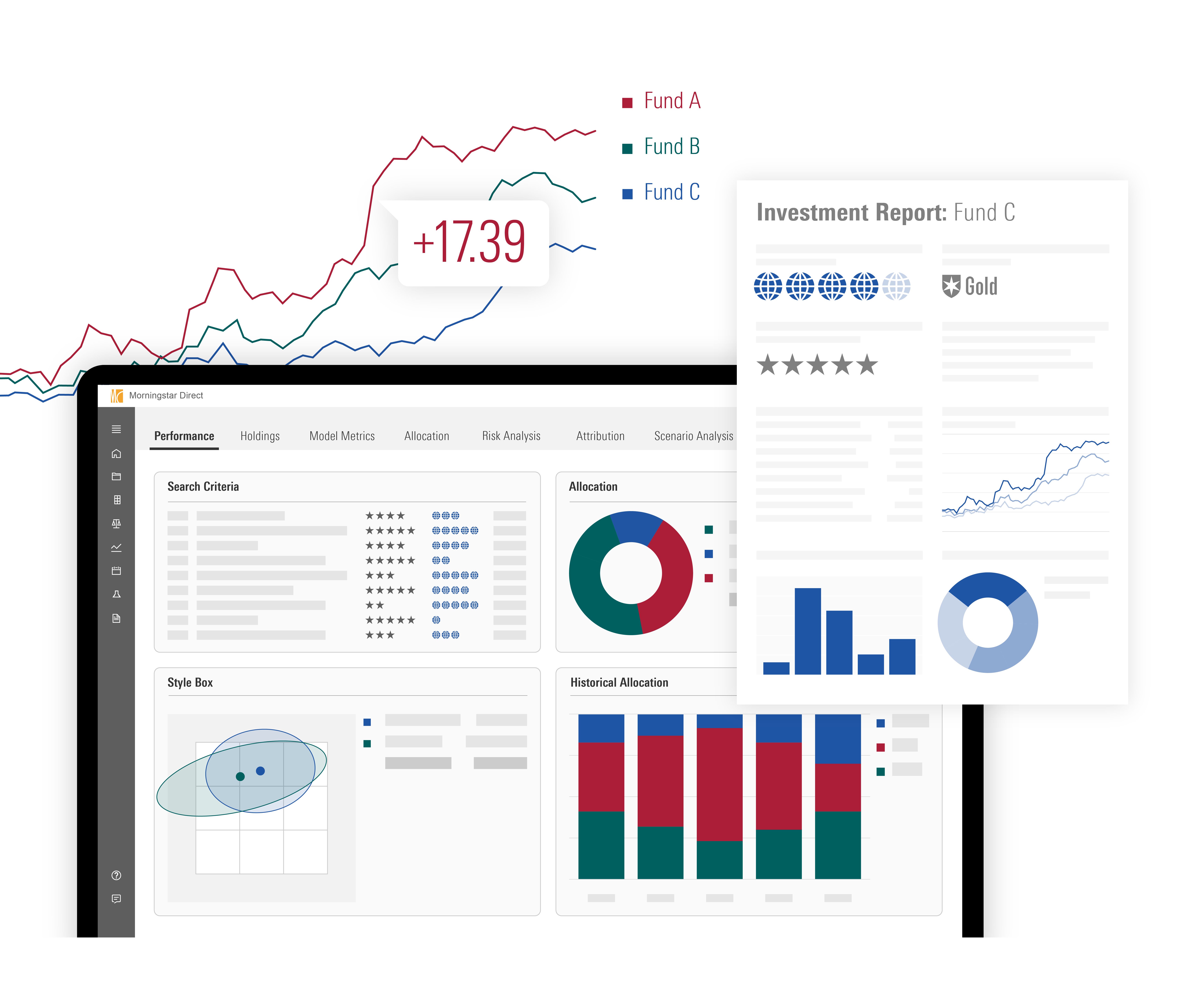
Solutions for Marketers
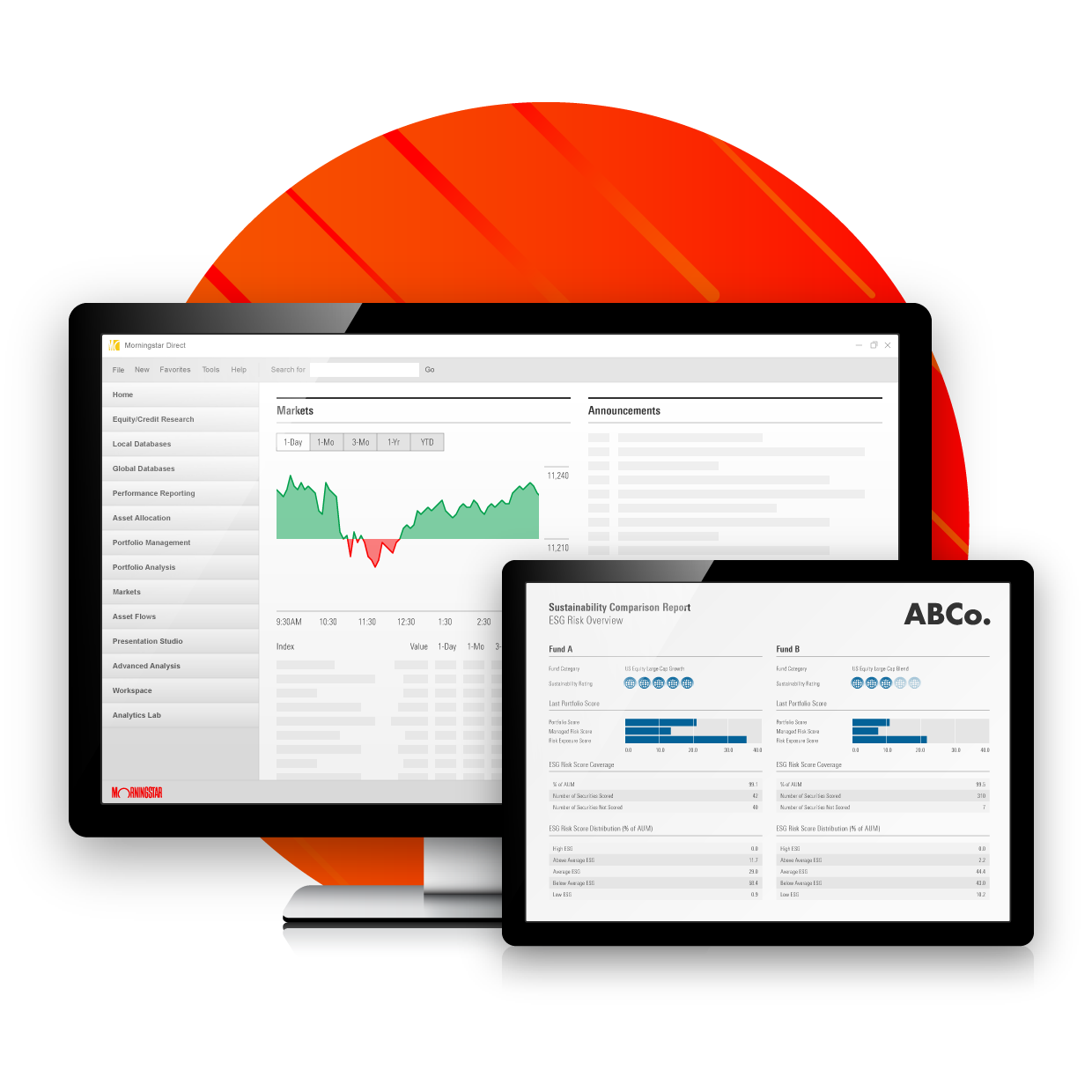
Morningstar Direct
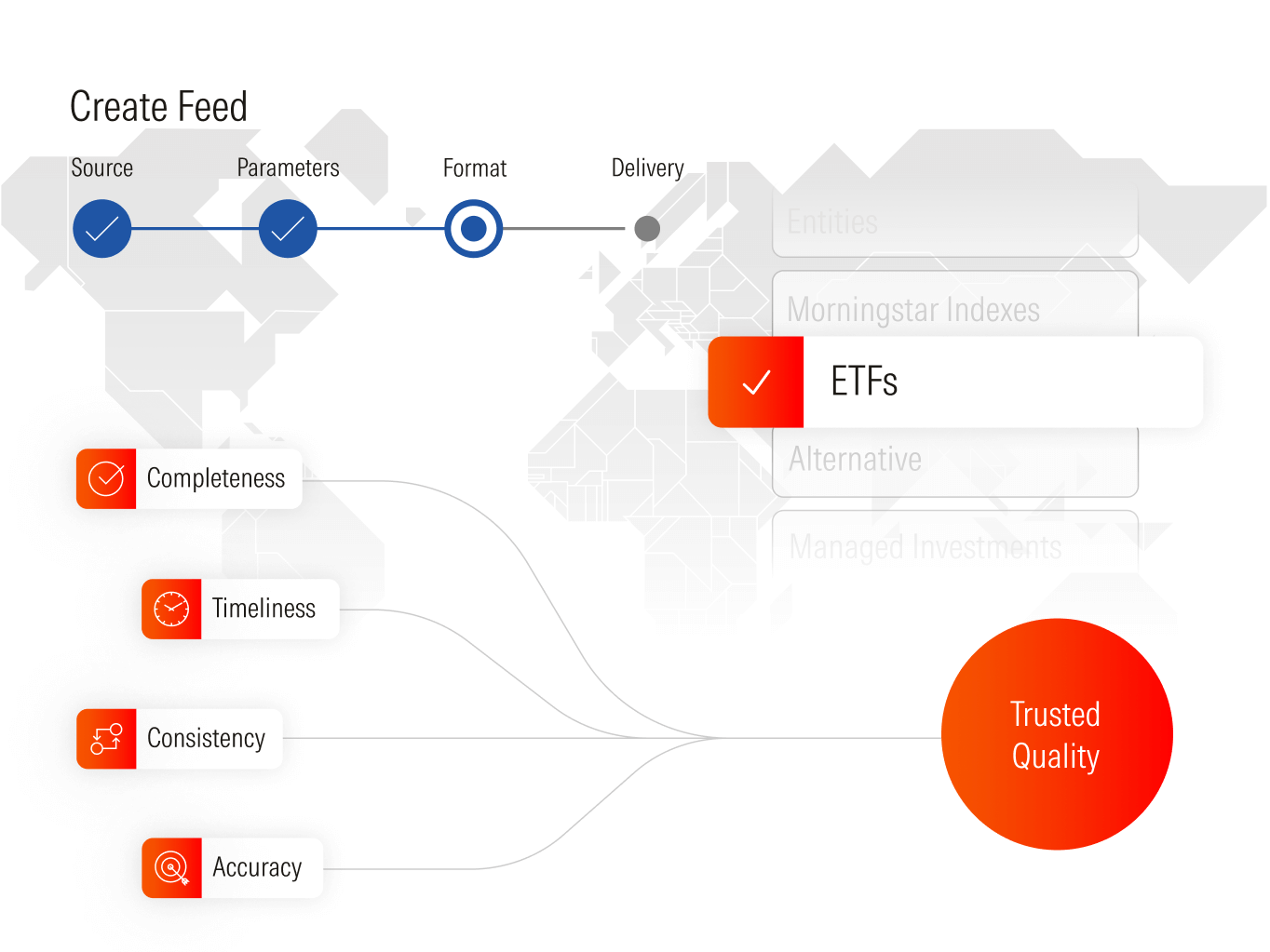
Morningstar Licensed Data
Navigating Market Volatility Through Fund Flows Data
Market volatility can shake investor confidence, but understanding fund flows can provide clear guidance during uncertain times.
With Morningstar Direct to analyze fund flow data, investors can decode trends across asset classes and uncover insights into investor behavior.
Click the image below to watch a short video on how.
Key Takeaways
- Monthly fund flows reveal the shifting tide between active vs. passive.
- Despite generally positive direct asset flows for most of the past year, April 2025 saw a significant downturn with negative flows, indicating a shift in investor sentiment or market dynamics.
- Flows data is updated monthly, providing a timely view into investor sentiment and market dynamics.
What Are the Types of Fund Flows?
With the right analysis, fund flows information can tell a larger story about investors.
Global fund flows
Fund flows by domicile show how investor behavior differs by country.
With detailed global data, asset managers can make informed decisions on upcoming product launches.
Flows by fund family
Fund family flows roll up all the funds by brand name for a big picture look at competitor performance.
Grouping flows by fund family can illustrate gaps in competitor coverage. You can see patterns in new product launches and pending fund shutdowns.
Morningstar Category fund flows
Category fund flows offer a detailed lens for analyzing investor preferences. The Morningstar category reflects the underlying securities, not the prospectus. In the United States, Morningstar organizes funds into 122 categories that map to nine category groups.
Passive vs. active fund flows
Over the last two decades, the U.S. market has undergone a tidal shift from active to passive investment vehicles. Market lows, when valuations drop, create a crunch for mutual fund managers who generate asset-based fees.
Asset flows can illuminate corners of the market where active management continues to drive mutual fund inflows. The choice between an active and passive investment strategy is a personal one. Asset flows by distribution channel can help understand the target audience of each approach.
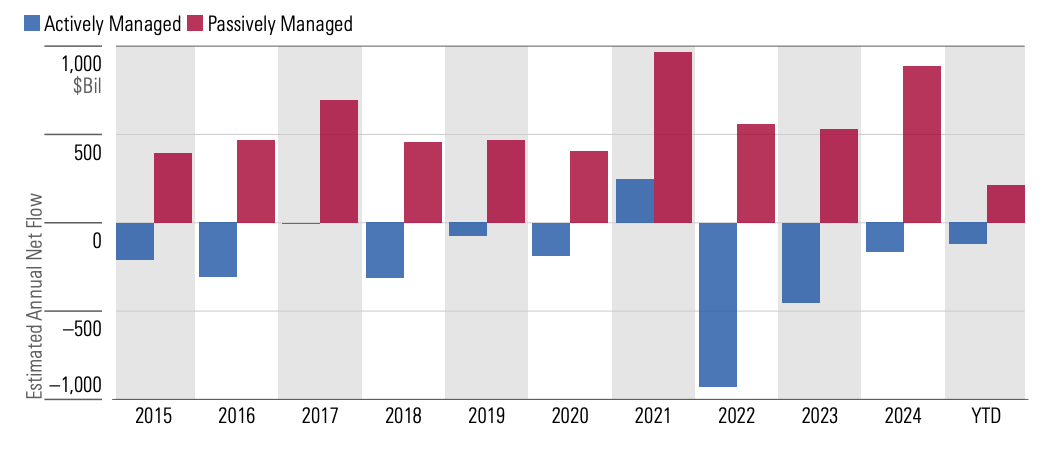
Source: Morningstar Direct Asset Flows. Data as of April 30, 2025.
Fund Flows by Asset Class
Because funds can contain a range of products—bonds, stocks, alternative assets—fund flows also shine a light on how investors feel about the underlying asset classes.
Fixed income has dominated flows for the past 10 years
Fixed-income open-end funds and ETFs had more than $1 trillion in global flows by December of 2024, more than doubling 2023’s $428 billion mark. However, enthusiasm among US investors faltered in April 2025, when bond-fund investors ran toward the exits at a rate last seen in 2022.
Taxable-bond funds saw $43 billion leave by mid-April 2025, their largest outflow since March 2020 and equivalent to their worst monthly organic growth rate since June 2022.
Equity notches modest growth in 2024
While fixed income scored an annual flow record, equity's share of long-term assets in mutual funds and ETFs increased to 63% thanks to robust equity markets. That story changed with US tariff announcements that sent markets tumbling.
In April 2025, most US equity categories suffered outflows. The main bright spot was the passive large-blend group, which often enjoys inflows regardless of the market. Small-blend funds had a rougher go. They endured a $6 billion outflow, their most ever and equivalent to 1% of their assets at the end of March—the worst organic growth rate since 2017. Small-growth and mid-cap value funds similarly posted organic growth rates that ranked among the worst over the past 15 years.
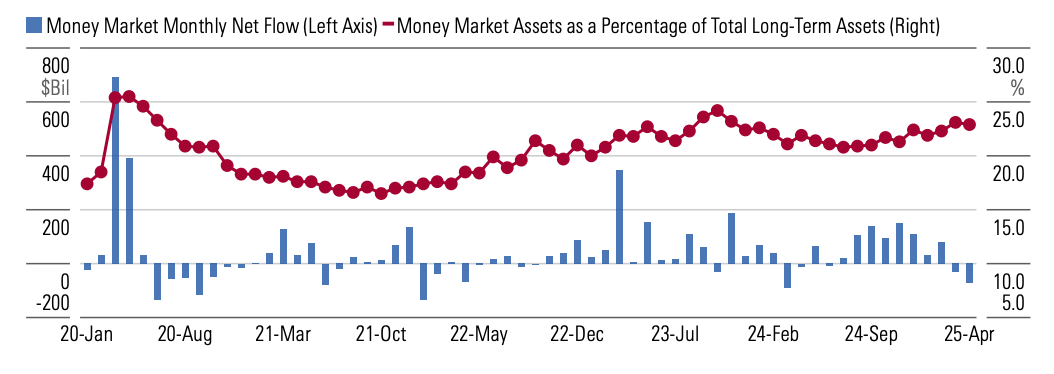
Source: Morningstar Direct Asset Flows. Data as of April 30, 2025.
Money market flows turned negative in March, but remain at a historically normal level
In early 2020, likely driven by uncertainty surrounding the pandemic, investors poured cash into money market funds in search of safety, sharply increasing their share of total assets (as seen in the spike of the blue bars and red line). Global money market funds hit an all-time high of USD 8.9 trillion in assets at the end of 2024 on flows of USD 951 billion. The category now represents 18% of long-term assets, its highest level since 2012.
Some pundits were concerned that “record money on the sidelines” signals an overheated stock market, but the rate was much higher during the global financial crisis in 2008 and the years that followed. US money market funds saw some outflows in April, but held steady as a percentage of total long-term assets.
Key Takeaways
- Fixed-income funds saw massive global inflows in 2024 but faced significant outflows in April 2025 among US investors, particularly in taxable bonds.
- Robust markets boosted equity's asset share in 2024, yet most US equity categories, especially small-blend and mid-cap funds, experienced outflows in April 2025.
- Money market funds reached record asset levels by late 2024 due to safety-seeking, maintaining a high, albeit historically normal, percentage of long-term assets despite some April 2025 outflows.
Fund Flows in Charts
ETF growth rates are increasing
ETFs have been the belle of the ball since the global financial crisis, and their dominance in capturing net flows over the past decade has been relentless. They have captured $7.4 trillion in flows over this period, while open-end funds have been treading water, taking in only $128 billion. That said, open-end growth rates have improved after a dreadful 2022.
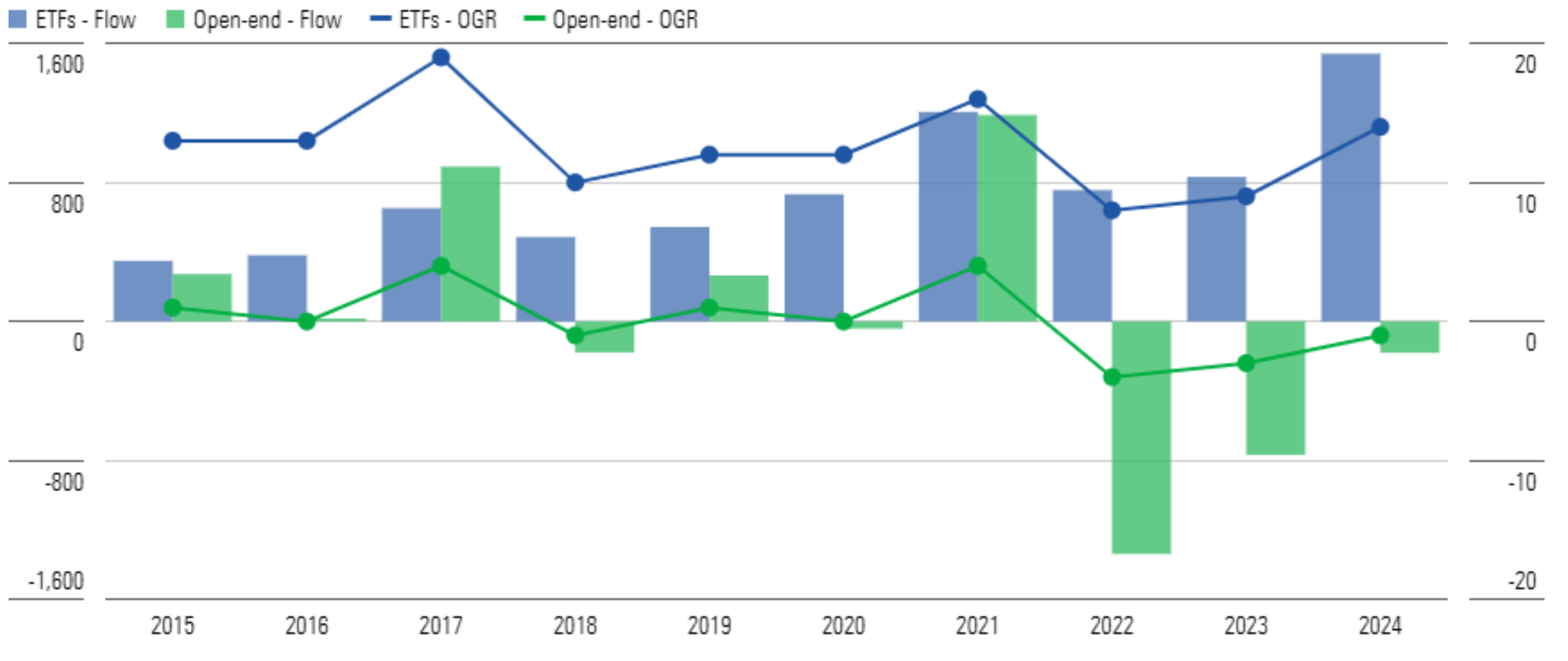
Source: Morningstar Direct. Data as of March 31, 2025.
Sustainable funds saw record-high outflows
Global sustainable open-end and exchange-traded funds experienced record-high outflows in the first quarter of 2025 amid new geopolitical challenges and an intensifying environmental, social, and governance backlash. Investors withdrew an estimated USD 8.6 billion, contrasting with the restated inflows of USD 18.1 billion in the previous quarter.
The United States suffered its 10th consecutive quarter of withdrawals, reaching USD 6.1 billion in the last three months. Asia ex-Japan also bled money, registering redemptions of USD 918 million, following a restated inflows of USD 2.8 billion in the fourth quarter of 2024. Meanwhile, outflows from Japan extended to the new year but improved to under USD 900 million, from USD 1.1 billion in the previous quarter. By contrast, investors in Canada and Australia/New Zealand poured net new money into sustainable funds. Each market garnered inflows of around USD 300 million.
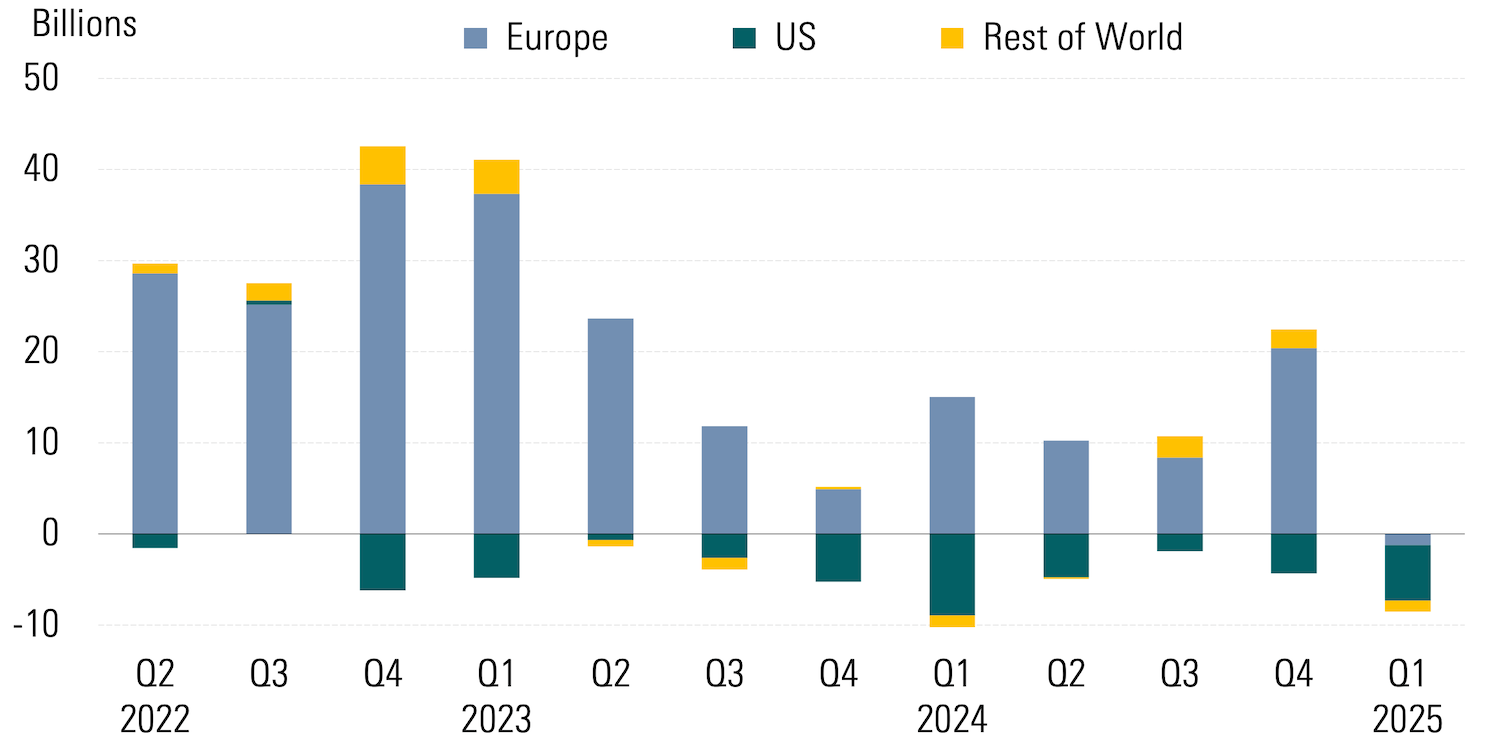
Source: Morningstar Direct. Data as of March 2025, excluding money market funds, funds of funds, and feeder funds. For Canada and the US, the number of funds includes funds of funds and feeder funds (these are, however, excluded from flow and asset calculations). For Japan and South Korea, the number of funds, flows, and assets includes funds of funds and feeder funds.
Diversifying funds stood out in April
US funds offering differentiated risk characteristics fared well in April. Alternative funds took in $3.6 billion (mostly driven by flows into digital assets funds); commodities funds gathered $5 billion (mostly driven by flows into gold ETFs); and nontraditional equity funds enjoyed their usual inflows to covered-call and defined-outcome products.

Source: Morningstar Direct Asset Flows. Data as of April 30, 2025.
How Can Asset Managers Use Fund Flows Information?
Flows can help inform marketing as a window into investor preferences. Do investors choose funds based on their recent performance or low expenses? How can fund managers position their products in line with investor expectations?
Asset flows can also help firms prioritize which funds to promote in what regions. Shift resources to products that reflect investor interest.
Fund flows shed light on AUM trends across major fund families. Find gaps in the competition and discover ways to differentiate your firm.
Asset Flows in Morningstar Direct
Morningstar Direct gives users the data, research, and analysis they need on over 600,000 collective investments. In the platform, asset managers can show how their investment stories relate to the broader markets, compare products with the competition, and present their findings in compliance-friendly reports.
Morningstar’s asset fund flows data dates to 2008, with forecasting models for future growth rates. Direct includes all fund flows data at one price with its performance reporting, presentation, and search capabilities. The Direct team also supports new users with onboarding, training materials, and 24-hour customer service.
Customize your fund flows research. Schedule a demo today!